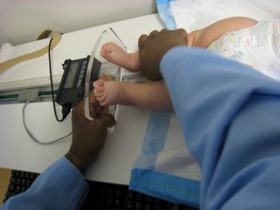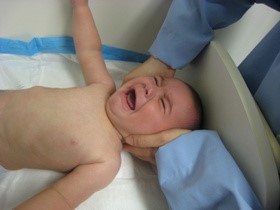Protocol - Height - Recumbent Length
- Arm Span
- Body Mass Index
- Body Proportions
- Ethnicity and Race
- Maximum Adult Height
- Weight - Measured Weight
- Weight - Self-Reported Weight
Description
Recumbent length is measured from the top of the participant’s head to his or her heels while he or she is lying recumbent. This measure is taken on neonates, infants, and young children.
The Anthropometrics Working Group suggests that the measurements be taken to the nearest 0.1 cm.
Specific Instructions
Three measurement protocols (Standing Height, Recumbent Height, and Knee Height) accommodate various groups of participants. Self-Reported Height should be used as a last resort only. Several overarching, critical issues for high-quality data collection of anthropometric measures that optimize the data in gene-environment etiologic research include (1) the need for training (and retraining) of study staff in anthropometric data collection; (2) duplicate collection of measurements, especially under field conditions; (3) use of more than one person for proper collection of measurements where required; (4) accurate recording of the protocols and the measurement units of data collection; and (5) use of required and properly calibrated equipment.
The notion of recommending replicate measurements comes from the reduction in random errors of measurement and accompanying improved measurement reliability when the mean of multiple measurements is used rather than the a single measurement. This improvement in measurement reliability, however, depends on the reliability of a single measurement in the hands of the data collectors in a particular study (Himes, 1989). For example, if a measure such as standing height in a given study has a measurement reliability of 0.95 (expressed as an intraclass correlation coefficient), taking a second measurement and using the mean of the two measurements in analyses will improve the reliability to only 0.97, yielding only a 2% reduction in error variance for the additional effort. If, in the same study, the reliability of a single triceps skinfold measurement was 0.85, using the mean, including a replicate measurement, would raise the reliability to 0.92 and yield a 7% reduction in error variance, more than a three-fold improvement compared with recumbent length. Because the benefits of taking replicate measurements are so closely linked with the existing measurement reliability, it is recommended that as a part of the training of those who will be collecting anthropometry data, a reliability study be conducted that will yield measurement reliability estimates for the data collectors, protocols, settings, and participants involved in that particular study (Himes, 1989). If the measurement reliability for a single measurement is greater than or equal to 0.95, the recommendation is that replicate measurement are not necessary and will yield little practical benefit. If the measurement reliability is less than 0.95, the recommendation is to include replicate measurements as prescribed.
If replicate measurements are indicated because of relatively low reliability, a second measurement should be taken, including repositioning the participant. A third measurement should be taken if the first two measurements differ by more than 1.0 cm. If it is necessary to take a third measurement, the two closest measurements are averaged. Should the third measurement fall equally between the first two measurements, all three should be averaged.
Standing Height, Recumbent Length, and Knee Height protocols are part of an examination study. Self-Reported Height may be part of a personal or self-administered interview.
Note: Detailed videos illustrating the procedure can be found here: https://www.youtube.com/watch?v=jpfT7oh-z3w
Availability
This protocol is freely available; permission not required for use.
Protocol
Height – Recumbent Length
- 1. Recumbent length is measured using an infantometer with a fixed head piece and horizontal backboard, and an adjustable foot piece. Position the SP. Lay the child on a Chux pad on the infantometer with the feet toward the foot piece and the head against the fixed head piece. If the child is not wearing a MEC examination gown, ask the parent or guardian to remove the child’s clothes except for diapers or underpants. The parent can use the changing table in the room to remove the child’s clothes. Place a Chux pad on top of the changing table and ask the parent or guardian to use it to remove the child’s clothes.
Placing infants and small children in a recumbent position often generates a sense of insecurity and consequently invokes a crying response. To help comfort the child, the parent or guardian should be encouraged to stand between the examiner and recorder, make eye contact, and talk to the child throughout the procedure.
The recorder supports the child’s head while the examiner positions the feet and ensures that the head lies in the Frankfort (see Standing Height). Apply gentle traction to bring the top of the head in contact with the fixed head piece. Secure the child’s head in the proper alignment by lightly cupping the palms of your hands over the ears (Exhibit 1). Align the child’s legs by placing one hand gently but with mild pressure over the knees. With the other hand, slide the foot piece to rest firmly at the child’s heels (Exhibit 2). The toes must point directly upward with both soles of the feet flexed perpendicular against the acrylic foot piece. To encourage the child to flex the feet, run the tip of your finger down the inside of the foot.
Note: If you are unable to achieve both legs outstretched in the correct position, make certain at least one leg is straight with the foot flexed against the foot piece. However, only position with one leg as an exception for extremely fussy children, making sure that the child’s body remains straight in the infantometer.
- 2. Capture the Result. When the child is correctly positioned, capture the result. Release the child’s feet as you hold the foot piece in position. After verifying the correct value, have the parent or guardian remove the child from the infantometer. Slide the foot piece to the end of the measurement column in preparation for the next participant.
In the event of a power outage or if the infantometer malfunctions, position the child as described above and obtain the recumbent length using a tape measure.
Exhibit 1. Recumbent length head position

Exhibit 2. Recumbent length feet position

Personnel and Training Required
None
Equipment Needs
None
Requirements
| Requirement Category | Required |
|---|---|
| Major equipment | No |
| Specialized training | No |
| Specialized requirements for biospecimen collection | No |
| Average time of greater than 15 minutes in an unaffected individual | No |
Mode of Administration
Physical Examination
Lifestage
Infant, Toddler, Child
Participants
This measure includes four protocols, and each protocol relates to the age of the participant and his or her ability to stand up straight. A fourth protocol for self-reported height is included but is considered a protocol of last resort when direct measurement of height or its proxy is not possible.
Standing Height
The standing height protocol is used for participants 2 years of age or older who can stand unassisted.
Recumbent Length
The recumbent length protocol is used for all infants and children from birth through 47 months of age.
Knee Height
The knee height protocol was used for participants 60 years of age or older or for individuals who cannot stand unassisted.
Self-Reported Height*
Study subject aged 16 years or older or by a knowledgeable adult proxy for children younger than 16 years of age.
*NOTE: Self-reported height values are considered to be less accurate and are used only when measured height cannot be obtained.
Interpretation:
The Centers for Disease Control and Prevention (CDC) and the American Academy of Pediatrics recommends that children from birth to 2 years of age be followed for length using the CDC-World Health Organization standard, available at http://www.cdc.gov/growthcharts/who_charts.htm.
Centers for Disease Control and Prevention. (2010). Use of World Health Organization and CDC growth charts for children aged 0–59 months in the United States. MMWR, 59(No. RR-9), 1-15.
Selection Rationale
The National Health and Nutrition Examination Survey 2021-2023 protocols were selected as best practice methodology and are the most widely used protocols to assess height.
Language
Chinese, English, Spanish
While the English version of this protocol has been updated, the available translations have not and reflect a previous version. These differences may impact the compatibility between the English and Spanish/Chinese versions. It is the responsibility of the investigator to determine if the translations are sufficiently compatible with the English version for their research and subsequent analysis.
Standards
| Standard | Name | ID | Source |
|---|
Derived Variables
None
Process and Review
The PhenX Steering Committee (SC) reviewed this protocol in October 2023. Guidance from the SC includes:
- Updated protocol
Protocol Name from Source
National Health and Nutrition Examination Survey (NHANES), Anthropometry Procedures Manual, 2021-2023
Source
Centers for Disease Control and Prevention, National Center for Health Statistics. National Health and Nutritional Examination Survey (NHANES) 2021-2023. Anthropometry Procedures Manual (Section 3.4.3 - Standing Height). Hyattsville, MD: U.S. Department of Health and Human Services, Centers for Disease Control and Prevention.
Certification for the Spanish translation can be found here.
General References
Himes, J. H. (1989). Reliability of anthropometric methods and replicate measurements. American Journal of Physical Anthropology, 79, 77-80.
Protocol ID
20705
Variables
Export Variables| Variable Name | Variable ID | Variable Description | dbGaP Mapping | |
|---|---|---|---|---|
| PX020705_Height_Recumbent_Length_Height | ||||
| PX020705010000 | Measure child from head to toe | N/A | ||
Measure Name
Height
Release Date
September 16, 2024
Definition
Height is the distance from the top of the participant’s head to the heels of his or her feet (i.e., the vertical length).
Purpose
Height or stature is used to assess body size and bone length. Recumbent length is used to measure length of infants, and knee height may be used to estimate height when stature cannot be measured in older adults.
Keywords
Anthropometrics, body mass index, BMI, stature, Waist-to-Height Ratio, WHtR, NHANES, gerontology, aging, geriatrics
Measure Protocols
| Protocol ID | Protocol Name |
|---|---|
| 20701 | Height - Knee Height |
| 20705 | Height - Recumbent Length |
| 20706 | Height - Standing Height |
| 20707 | Height - Self-Reported Height |